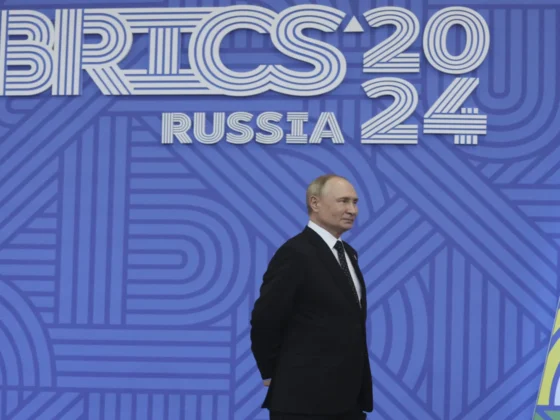Image credit/license
Russians seem to be trapped in an echo chamber of propaganda: The polling suggests that most Russian adults consume news through state‐controlled media. Our own research shows that this is not only due to the suppression of independent news but also because many citizens genuinely trust state outlets. News consumers’ attachment to propaganda has helped the Kremlin to ensure public acquiescence to the war on Ukraine. In these circumstances, can a more critical attitude toward propaganda content be promoted to encourage Russians to consume alternative information sources?
In the autumn of 2023, as Russia’s full‐scale war in Ukraine was in its second year, we conducted a novel study to understand, first, to what extent Russians notice that their media is biased in favor of Putin’s regime, and second, whether they can learn to consume information more thoughtfully and become more cautious about propaganda. As a result of our intervention, the study participants became more aware of the pro‐government bias of state television. In addition, the study sparked increased interest in independent broadcasts and made respondents more concerned about Putin’s regime and the war in Ukraine. Nonetheless, even as they acknowledged the bias of propaganda, most did not turn away from state news outlets. Indeed, the intervention affected only those who were already skeptical about the regime and interested in independent media. These results suggest that attempts to provide Russians with truthful information about the war in Ukraine are inherently limited, but more opportunities may open in the future if support for the Kremlin erodes.
Detecting Media Bias
To investigate Russians’ capacity to recognize pro‐government bias in news, we recruited over 2,000 participants for a series of online surveys. In these surveys, we asked them to watch and evaluate recent news broadcasts by Russia’s flagship state TV station, Rossiya‐1, and a private TV channel RTVI, which is politically more balanced.
There has been a steady flow of studies in the U.S. and other countries aiming to correct misperceptions, false beliefs, and perceptions of media bias, but staging such interventions in today’s Russia is challenging. Any direct suggestion that citizens should be skeptical about official propaganda may be perceived as political interference, especially coming from Western researchers.
We developed an innovative approach to overcome this limitation: Instead of trying to directly convince Russians that state media outlets advance a pro‐regime agenda, we nudged them so that they might come to such conclusions on their own. We presented our study as a series of simple content analysis tasks, asking respondents to count how often the news segments mentioned Russia, Russian officials, and other countries in a good or bad light, as well as whether the content was professionally made. There were 16 such tasks across three survey waves, which gave our respondents time to deliberate on the political tilt of the news reports. Considering the content of state TV in this way should have made its propagandistic inclinations evident, even without any direct suggestions from researchers.
To measure how well such interventions work, we designed an experiment. Some respondents were to watch and evaluate segments by both the state channel Rossiya‐1 and the nonpolitical channel Kultura (which covers theater, architecture, art, etc.), whereas others only watched segments by Kultura. The former group should have better understood the political bias of Rossiya-1 and grown more skeptical about it than the latter group. A third group of respondents examined both Rossiya‐1 and RTVI, which subtly nudged them to compare the pro‐regime Rossiya‐1 coverage with the more balanced reporting of RTVI and decide on their own which channel was more truthful.
Importantly, our surveys were separated by several weeks, and only at the end, two weeks after respondents completed the final set of tasks, did we ask them to report on their understanding of the editorial stances of Rossiya‐1 and RTVI, and whether these TV stations were unbiased and politically independent. That allowed us to see whether the experiment had produced any lasting effects on learning about the media. We also asked participants about their news consumption, perceptions of the Russian government, and concerns related to Russia’s war on Ukraine.
Russians Notice that State and Independent Media Cover Politics Differently
A more or less careful examination of news content indeed brought to light the pro‐regime direction of the state TV station for our respondents. When they examined Rossiya‐1, they noticed more positive mentions of Russia and the Russian authorities, along with more critical coverage of other countries, in comparison to both the nonpolitical channel Kultura and the more politically balanced RTVI. Moreover, participants remembered these differences weeks later, in the final survey wave, when we asked them about the general strategy of the two channels. They even got better at guessing which channel published which news stories when we showed them several additional headlines.
Even though our participants clearly recognized that Rossiya‐1 was more pro‐government, the intervention did not spur skepticism toward this channel. Apparently, Russians in our study did not view the pro‐regime agenda of the propaganda channel as something overly concerning.
In contrast, the respondents whom we asked to analyze RTVI’s news segments came out of the survey with a more positive view of this channel, seeing it as less biased and more independent. This shows that Russians may value more balanced news coverage in principle, even if they are not especially upset by the propagandistic direction of state media organizations.
Attention to Coverage Boosts News Interest, Demand for Independent Media
When analyzing the effects of our intervention on news consumption, we saw similar patterns.
The respondents who examined RTVI videos throughout the study were more likely to start getting news from this more balanced outlet. When people were being recruited for the study, just a few percent of them reported watching RTVI for news. By the end, 9 percent of those in the first two groups (which examined only Kultura or Kultura and Rossiya-1) mentioned RTVI as a news source, whereas the figure was 23 percent among those who had compared Rossiya‐1 and RTVI—that is, the intervention more than doubled the number of RTVI news consumers. In addition, we gave participants another news evaluation task and asked them to choose the channel they would like to analyze. In the control group, 10% chose RTVI, whereas in the group that compared Rossiya‐1 and RTVI, 20% opted for the latter.
A more concerning outcome was that analyzing Rossiya‐1 also prompted more respondents to get news from the channel, even though its consumption was already very high. In the control group, 72 percent reported watching Rossiya‐1, versus 77-78 percent in the treatment groups. One possible explanation is that our intervention increased overall interest in news, and even when presented with a more balanced alternative, participants did not stop consuming television propaganda.
Intervention Induces More Critical Political Attitudes
Finally, our intervention somewhat shifted participants’ broader political views. In the final survey wave, the respondents who analyzed the content by Rossiya‐1 or RTVI reported lower approval of the Russian authorities and expressed more concerns about Russia’s war on Ukraine and its consequences for their country. These differences were not dramatic but tangible, and crucially, the dissatisfaction was still lingering weeks after respondents completed their last content analysis tasks.
There are two possible interpretations for these results, and they are not mutually exclusive. First, it could be that learning to process news reports more carefully spurred greater concern, since participants were more likely to notice the negative aspects of political news coverage—not only in the video segments we showed to them, but also in the news stories they consumed on their own every day. Second, since our intervention increased interest in, and improved the perception of, more independent media sources, respondents may have become more receptive to the critical reporting of RTVI and other such news outlets, and consuming that content increased their skepticism about the Russian government’s policies and performance. We find some support for the second possibility: Every week, we quizzed our respondents on recent events, and awareness of major headlines increased among those who analyzed the content of Rossiya‐1 or RTVI.
Pro‐Putin Russians Prove Resistant to Learning
We have found that Russians’ interest and receptiveness to more critical information increases when they are exposed to more objective and balanced sources and prompted to be careful in their news consumption. Although this outcome is encouraging, in connection with certain effects of political media and political messaging it is usually worth asking: Do these treatments work for everyone or just for some people? And who is most affected? Some additional results that we have obtained provide useful corrections.
We examined how pro‐Putin respondents—those who approve of the Russian president—and opposition‐minded participants reacted to our intervention. While both noticed the pro‐government slant of Rossiya‐1 and the more balanced approach of RTVI, only Putin critics became more interested in RTVI and more receptive to independent reporting. Putin supporters did not change their news consumption behavior, and neither did regular consumers of Rossiya‐1. Similarly, only Putin critics and the participants who were already consuming some independent media became more skeptical about the government and more concerned about the Russia-Ukraine war. In other words, for interventions such as ours to work, citizens have to be already somewhat open to critical information.
Conclusion: News Literacy Interventions Increase Interest in Alternative Sources but Cannot Erode Propaganda’s Influence
On the one hand, we find that simple and short news literacy exercises can increase awareness of alternative viewpoints and critical attitudes to the dominant propaganda line. The experiment we ran required only a few hours of attention over the course of two months, yet it substantially boosted interest in more balanced political reporting and exposure to such reporting, while encouraging some rethinking of the desirability of government policies. If our respondents had continued to complete these simple tasks, the effects would probably have grown stronger over time—repetition typically reinforces learning.
Moreover, our study shows that such news literacy efforts can work in authoritarian regimes like Russia and be impactful despite widespread censorship and mass propaganda campaigns.
At the same time, we should be mindful of how much such interventions can achieve. While our experiment shows the importance of exposing Russians to independent information and critical media, it also demonstrates a deeper pattern of receptiveness or resistance to such information that is at play. Authoritarian publics are often resistant to critical information and willing to consume state media even after learning about the bias of propaganda. Only citizens who are already somewhat skeptical and interested in alternatives might react positively to news literacy education. At this point, research indicates that such people constitute a minority in Russia. Therefore, news literacy interventions and exposure to independent media sources should be more impactful when the pro‐Kremlin majority starts to crumble, but such information efforts cannot shatter this majority on their own.
Anton Shirikov is an assistant professor in the Department of Political Science at the University of Kansas.
Georgiy Syunyaev is an assistant professor in the Department of Political Science at Vanderbilt University.
Research for this study was supported by a grant from Columbia University’s Harriman Institute.
Image credit/license











